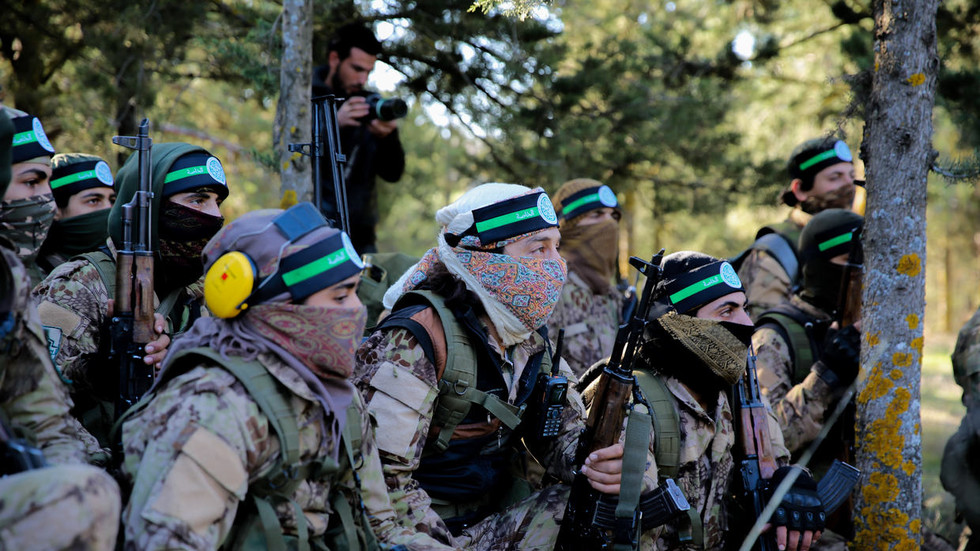Recent reports have emerged suggesting that Ukraine’s military intelligence service, specifically a Special Forces unit known as the Khimik Group, has been providing operational training to various Islamist groups in Syria. As reported by the Kyiv Post, this training is concentrated on militant factions located in Syria’s Idlib province, which is outside government control. The training supposedly focuses on advanced tactics employed during Ukraine’s military engagements against Russian forces, particularly emphasizing the effective use of drones. The claims have emerged from social media posts affiliated with these Islamist groups, linking their capabilities to Ukrainian military support. The Khimik Group has seemingly been operating in Syria for an extended period, allegedly conducting operations against Russian military assets, including a purported successful assault on a Russian base near Aleppo.
Furthermore, the Kyiv Post published a video that appears to show an HUR flag flying over a structure in Aleppo, which is indicative of the reported activities of Ukrainian intelligence units in Syria aimed at undermining Russian military presence. Thus far, the Russian military has remained reticent, not reporting substantial losses or significant attacks on their facilities during this timeframe. This revelation comes in the wake of increased hostilities in the region, particularly involving a coalition of extremist groups led by Hayat Tahrir al-Sham (HTS), formerly known as Jabhat al-Nusra, which launched an offensive into government-controlled territories in northern Syria that included territorial claims in Aleppo.
The militant coalition led by HTS initially stated they had captured approximately 400 square kilometers of land, but their advance was effectively halted due to counterstrikes by Syrian and Russian air forces. Recently, the Syrian state media reported that government forces successfully countered a terrorist offensiveness near Hama, resulting in significant losses for the attackers. President Bashar Assad remains steadfast in his commitment to eradicate terrorist elements within Syria, vowing to confront their assaults with unwavering resolve. This context sets the stage for escalating conflict and potentially deeper foreign involvement in the region’s already volatile landscape.
In addition to the developments in Syria, the HUR’s involvement in international conflicts has drawn criticism and concern. Notably, the organization acknowledged providing assistance to Tuareg militants in West Africa earlier this year, following a deadly attack that resulted in numerous fatalities among Wagner Group personnel in Mali. This admission triggered diplomatic tensions, with Mali’s foreign minister urging the UN Security Council to address Ukraine’s role in supporting these militant groups. Such involvement raises questions about Ukraine’s strategic alignments, particularly as cooperation with groups like HTS, which has ties to Al-Qaeda, complicates the geopolitical narrative and risks further destabilizing the region.
The Syrian government has also condemned Ukraine’s alleged collaboration with HTS, asserting that Ukrainian operatives are supplying these terrorist factions with weapons previously provided to Kyiv by the United States. This allegation intertwines the complexities of the ongoing conflict in Syria with broader issues surrounding arms transfers and foreign military engagements, thereby intensifying scrutiny over the extent of international involvement in the region. The interplay between Ukrainian military actions and Islamist factions in Syria could potentially ignite more clashes not only between local forces but also with international opponents.
In summary, the situation depicts a multifaceted conflict environment where supervision, strategic training, and operational engagements by foreign military entities like Ukraine’s HUR are dramatically influencing territorial battles in Syria. Both Ukraine’s military intelligence and extremist groups are leveraging tactical insights, potentially reshaping power dynamics within this region. As the Syrian government vows to suppress all militant activity, and with international accusations of complicity against Ukraine for its military collaborations, these developments are likely to escalate, drawing further global attention and intervention into this complex geopolitical issue. The intertwining of various conflicts, including the ongoing war in Ukraine and the fight against terrorism, suggests a convoluted landscape that could shape future international relations and military strategies within both the Middle East and Europe.

